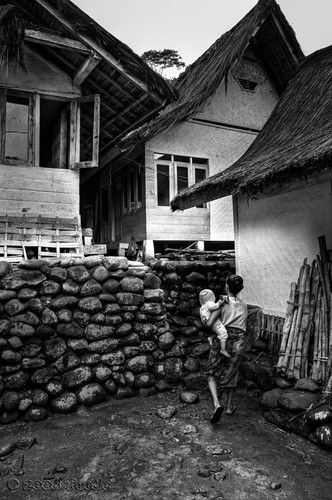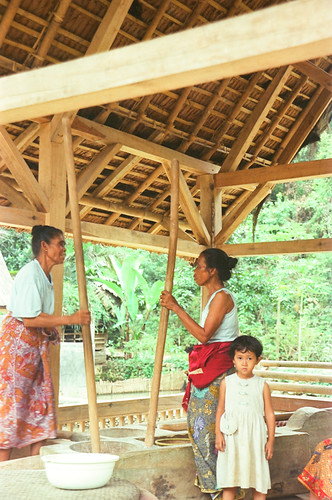It turns out that Indonesia already have a green architecture concept since hundreds of years ago. And this work of local genius is still preserved by traditional means: through all sorts of restrictions / taboos / pamali.
In Kampung Naga which is located between the highway Tasik and Garut, Western Jawa, Kecamatan Salawu Neglasari, engineers with no degree that lived hundreds of years ago had lived with nature and try to defend its wisdom with all means. In the lush and humid river valley, where water is abundant with high rainfall that is continuesly preserved, one particular way is through environmentally friendly architecture and various taboos.
It is said that the origins of the name of Kampung Naga from the term 'diNA GAwir village' or 'village on the cliff', which eventually became the village of Naga alone ..
# 1
Restricted forest. There are two forbidden forest, the first area residents are prohibited from entering the forest for any reason, and the second area forest that can be entered only when there is a ceremony and must be accompanied by a Kuncen (elder gatekeeper who also know the history of a distinguished place), for purposes of pilgrimage to the tomb of their ancestors. Violation of this prohibition is cursed or exile.
As a result of these prohibitions, the water source maintains its sustainability. The village has never experienced drought and landslides. Kampung Naga area also should not be traded fo any reason.
# 2
The use of tight zoning or the division of the area. Areas are made terraced with stone piles without cement, and proven to withstand erosion. Area with the highest level are the most sacred, wherelies 'bale Ageung' (big hall) and big mosque. The lower area is residential, and its lowest level for fish ponds, livestock and public toilet areas.
# 3
Drainage channels are made between houses. Houses are all facing north-south and row -lined east to west. Roof are made of palm leaves and with base from a kind of laos leaves. The roof of these fibers will eventually overgrown with moss and became more leak-proof. The roof of a opposite houses form a natural gutter, while the side neighbour the rain gutters are made. High slope form roof ensure rain water does not splash back in reverse direction.
# 4
The structure of a house like this also proved to withstand earthquakes. When the Tasik big earthquake happened not one single house in here collapsed. The key is the foundation or base or the house that are made of massive stone and dont use any nails, but from the natural ropes. The house made of wood and bamboos so its make a very flexible structure.
# 5
House on stilts ensure the house is not damp and kept dry. Wooden floor became shiny because of frequent mopped. wooden plank placed in perfect spot at the wall to lean. Paints are prohibited, should only be limed. Tables and chairs also prohibited, as well as electricity. Some houses have a black and white battery operated television.
# 6
This is a headband style for the day-to-day activities. For ceremonies there area different headband style. Behind Pak Ndut is a leuit door for rice storage at home, and men are not allowed to opened it, should only be opened by his wife (women)only.
# 7
Rice container from a hollowed jackfruit tree trunk. In the left are rice steamer and its holder.
Firewood stove. Apparently the people here grow or buy firewoods, because its forbidden to take it from the forest. Above the stove is a 2 in 1 cooking equipment, rice steamer and water boiler. Kitchen floor from some sort of natural fiber woven mat, easy to clean and quick dry because dirts swept directly onto below the house.
# 8
The rice grown here is somewhat different type, larger in size and planting time is longer about 6 months. Rice is harvested using tool called ani-ani and hammered with mortar and pestle until the skin loose. This processed conducted as necessary every week. Strands of dried rice tied up and stored in a warehouse. Dozens types of rice planted for ceremonial purposes.



.jpg)
.jpg)
.jpg)
.jpg)

No comments:
Post a Comment